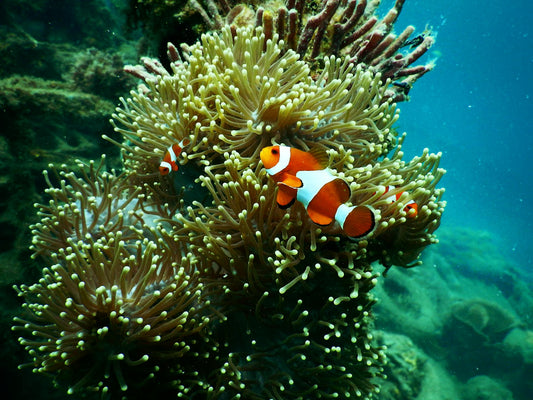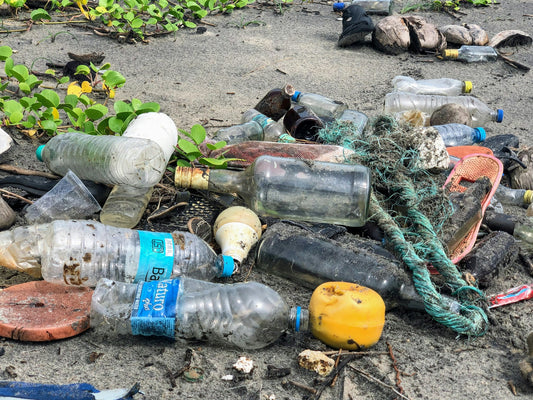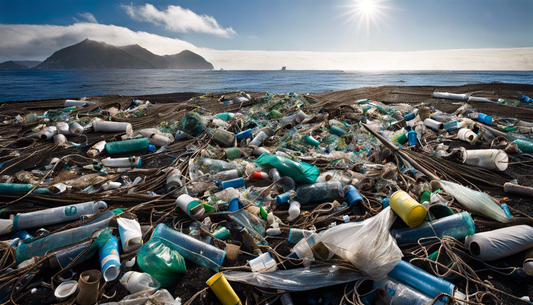Share
Plastic pollution in our oceans and on our shores has become a worldwide problem.
Currently, about 40 percent of the world’s ocean surfaces are covered with giant whirlpools that contain millions of tons of plastic and will exceed up to 950 million tons by 2050. If the current trends continue, the weight of plastic will likely exceed that of fish in the sea by 2050.
One of the most obvious and lethal consequences of plastic pollution is the direct impact on animals.
It is estimated that thousands of seabirds, sea turtles, seals, and other marine mammals die each year from ingesting plastic or becoming tangled in it.
Plastic waste can be found in various ecosystems from mountains to water bodies, affecting numerous organisms through physical trapping, ingestion, altering their living spaces, and chemical poisoning.
In this blog post, we will look at some of the animals most impacted by the plastic pollution crisis and why we must act now to solve this issue.
How Plastic Ends Up in Our Oceans

The sea organisms are known to be the most affected species due to plastic pollution. Let’s see why it’s a serious concern and how plastic enters our oceans.
- Waste on the land is managed poorly and hence plastic is washed by rain and wind from landfills, streets, and urban areas into the rivers and streams, and then into the ocean.
- Rivers, especially those in Asia and Africa with high populations and inadequate waste management systems, convey significant quantities of plastic waste from inland territories to the oceans.
- Microplastics are tiny fragments that are produced when larger waste and products disintegrate, water treatment plants do not filter them out so they find their way into the streams and seas.
- The majority of the plastics that are found in the seas and oceans are sourced from Marine litter is constituted mostly of plastics; about 6.5 million metric tons of plastic waste are introduced into the ocean annually.
- This plastic waste mainly stems from poor production procedures and fishing practices, and about 10% of the ocean’s plastic pollution is from industrial fishing.
Which Organisms Are Affected Due to Plastic Pollution in Water Bodies?

Sea Turtles
Sea turtles are especially endangered by plastic, as they confuse plastic bags for their favorite food – jellyfish.
Also, plastics such as fishing nets and other waste products that are thrown into the sea can trap sea turtles.
Hence, six of the seven species of sea turtles are regarded as threatened or endangered and plastic pollution is a major threat to sea turtles.
Whales
Some of the other animals that are affected by plastic waste include the whales such as beluga whales and fin whales.
These magnificent animals consume microplastics either by swallowing them whole or by consuming organisms that have fed on plastics.
Research has shown that microplastics are present in the stomachs of different species of whales and this has brought up questions on the impacts on their health.
It is estimated that around 100,000 marine mamals, including whales die each year from plastic pollution.
Seabirds
Seabirds are the other category of animals that suffer greatly from the effects of plastic pollution.
Seabirds are considered to be affected most by marine debris, and it is believed that 90% of seabirds have consumed plastic in some way, and the rate is expected to reach 99% by 2050 if no improvements are made.
It blocks the internal organs of seabirds and, together with the ingestion of plastic, leads to starvation.
A shocking 1 million seabirds fall victim to plastic pollution every single year.
Fish
Plastic pollution also greatly affects fish, especially in the North Pacific Gyre and the freshwater basins of the Great Lakes.
Some of these plastics are small and resemble fish food and can, therefore, be ingested, leading to severe effects such as digestive complications, stunted growth, and even death.
One thing that is to remember is that plastic can enter the human digestive system as well. If we eat fish that has consumed microplastic then it will eventually enter our bodies and cause severe consequences.
Amphibians
Frogs, toads, salamanders, and newts are some of the most sensitive groups of animals affected by plastic pollution in freshwater habitats.
Due to their complex life cycle that includes both aquatic and terrestrial habitats, the amphibians are very vulnerable to changes in their environment, especially as a result of pollution.
Microplastics pose a great threat to amphibians. These particles may be eaten by amphibians at different stages of their development –from the tadpole to the fully grown adult.
Microplastics can lodge in their digestive tracts, hinder their feeding processes, and introduce poisonous substances into their bodies.
Terrestrial Animals
Even though most efforts to control the use of plastics are directed toward aquatic life, plastics pose a threat to the lives of land animals as well.
As can be seen, the impact of plastic pollution on terrestrial animals is numerous and quite unforeseen, which only proves the scale of the problem.
Plastic Affects All Animals in Various Ways

As discussed above, plastic affects all animals from fish to amphibians and land mammals. Let’s discuss how different animals are affected due to plastic pollution.
Ingestion of Plastic Debris
Many species of terrestrial animals, such as mammals, birds, and reptiles, often consume plastic materials, thinking they are food.
This may cause severe health problems, including obstruction of the digestive system, poor digestion and absorption of nutrients, and internal organ damage.
Elephants, zebras, tigers, camels, cattle, and other land animals have been documented to ingest plastic waste, leading to internal injuries, hemorrhages, blockage of the digestive tract, and even death.
Entanglement and Mobility Impairment
Plastics like nets, ropes, and rings used in holding six-packs of beverages are fatal to land animals as they trap the animals and limit their movements, resulting in death or serious injuries.
Entanglement affects birds in particular; they are likely to get entangled.
The Ripple Effect on Ecosystems
Plastic pollution causes extensive harm that extends beyond individual animals, impacting entire ecosystems in significant ways:
Disruption of Food Chains:
These microplastics are swallowed by small organisms and then accumulate in the food chain, affecting fish, birds, and marine mammals, which suffer from diseases and death.
Habitat Degradation:
Litter, especially plastics, harms important ecosystems like coral reefs, seagrass, and mangroves. These are nurseries and feeding grounds for many species and thus lower biological diversity.
Chemical Contamination:
Plastics are a source of leaching of dangerous chemicals, and a magnet for other pollutants that have negative impacts on the endocrine system of marine life and susceptibility to diseases.
Loss of Biodiversity:
These impacts can result in local extinctions and a decline in species richness that can endanger ecosystem services that include nutrient cycling and coastal defense.
The facts and figures related to animals affected by plastic pollution are very devastating. We can all play an important role to reduce the suffering of animals from plastic pollution.
Everyone Can Help Protect Our Animals
By reducing our consumption of single-use plastic and supporting stringent measures dealing with the unsafe disposal of plastic, we can help to conserve the biodiversity of our planet for the future generations.
The facts and figures related to animals affected by plastic pollution are very devastating. We can all play an important role to reduce the suffering of animals from plastic pollution.
By reducing our consumption of single-use plastic and supporting stringent measures dealing with the unsafe disposal of plastic, we can help to conserve the biodiversity of our planet for the future generations.
What else can we do to protect these beautiful animals? Feel free to leave a comment below.
We hope you enjoyed this article. If you want to read more like this, make sure to check out our Blog and follow us on Instagram. If you are interested in truly sustainable products, check out our Shop.








